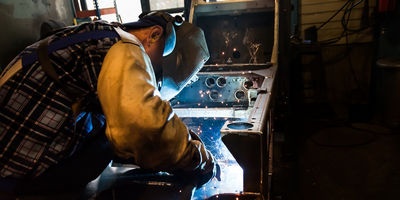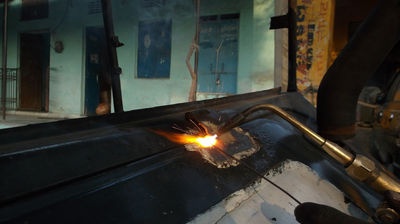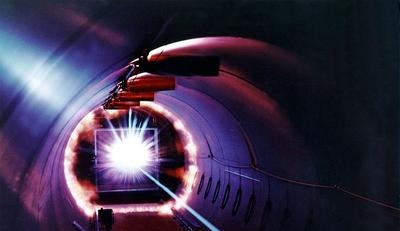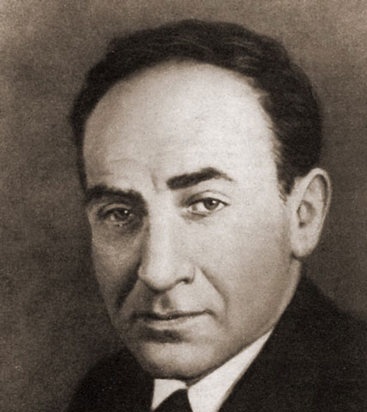|
 This welding method has not yet emerged from the laboratories. It is studied by research teams both here and abroad. As foreign journals write, the results obtained already give reason to expect much from the use of explosive welding. This welding method has not yet emerged from the laboratories. It is studied by research teams both here and abroad. As foreign journals write, the results obtained already give reason to expect much from the use of explosive welding.
This method is based on the simple fact that two pieces of metal, instantly compressed by a tremendous force, are connected firmly - so that you cannot tear them apart later. Explosive welding works best in a vacuum. In this case, the explosion does not have to overcome the buffer air gap between the parts to be welded.
When welding a structure at future orbital and interplanetary stations or metal structures on the Moon, air will not have to be removed - it is not there. But under terrestrial conditions, the parts must be placed in a vacuum chamber. This has the added benefit that the chamber walls protect the welder and that the noise from the explosion is no louder than the noise from the blows of a pneumatic riveting hammer. In order not to build too large a chamber for long parts, it is made movable, directly covering the welding zone. The open ends are covered with rubber shields or. packing material, especially since the vacuum is not needed especially deep - about 1 millimeter of mercury. However, good seams have already been obtained without any vacuum, in the open air.
You need to explosively weld two flat metal sheets. In practice it is done like this. The bottom sheet is placed on a heavy anvil plate to prevent deformation during welding, and thin foam support posts are placed between the sheets so that the angle between the surfaces to be welded is 2-4 degrees. If this angle is not maintained, welding may not work. The explosives are distributed in an even layer on the top sheet, placing a piece of rubber equal to it in thickness under it. In this case, the explosion pressure is transmitted more evenly, and the sheets do not crack. As for the anvil, you can do without it. In this case, only the second portion of the explosive is needed, which, on the other hand, would balance the explosion pressure.
So the preparations are over. Sheets, racks, explosives - everything is in its place. Impact on the capsule. Explosion! A tiny fraction of a second - and the details have become a single whole. How to trace, control the welding process if it goes with cosmic speed? In the literal sense of the cosmic sense: hot gases run several kilometers per second. High-speed X-ray photography helped to spy on the mysterious mechanics of an instant explosion, to look into an opaque vacuum chamber.
If we put the filmed film into an ordinary film projector, we will see that after the steel sheets touched their edges, an elastic shock wave ran along their inner surface at a speed of 5 thousand meters per second. The point of contact of the sheets ran after the wave and, like a zipper slider, sewed the sheets together tightly. Now it is easy to understand why an angle of 2-4 degrees was needed. If the angle between the sheets is smaller, the point of their contact will overtake the sound: the wavy surface necessary for adhesion will not have time to form, and the sheets will remain smooth - they will not weld. If the angle is too large, the sheets will move, their shape will be distorted, and welding will again fail.
 Research has shown that waviness provides a mechanical bond of enormous strength. In any case, in shear tests, the base metal always fails before the seam. The wave height is approximately 12 microns. Research has shown that waviness provides a mechanical bond of enormous strength. In any case, in shear tests, the base metal always fails before the seam. The wave height is approximately 12 microns.
Explosive welding helps to significantly reduce the number of "non-weldable" combinations unpleasant for welders - such as copper and gold, silver and steel, steel and nickel, molybdenum, niobium, titanium.
Generally speaking, the method of cold welding of sheets of dissimilar materials under pressure has been known before. It was proposed, for example, by the Soviet inventors G. Orlovsky and L. Adrianov. However, this method required careful surface pretreatment and bulky, expensive presses. And when welding with an explosion, colossal pressures are provided - up to 70 thousand atmospheres! - practically without any equipment. And this, of course, is extremely convenient when in the field it is necessary to cook large tanks, poorly straightened sheets, heavy elements of railway bridges.
At the same time, the explosion is capable of performing filigree, jewelry and even work inaccessible to the most skillful jeweler.
... For one electronic device, a part was needed, consisting of 1,300 hexagonal copper cells with a wall thickness of 50 microns and a hole size of approximately 0.7 millimeters. Real honeycombs, only much more delicate. The technologists threw up their hands in despair: none of the known ways to make a part was impossible.
Then the welders cut 1,300 pieces of large aluminum wire, electrolytically covered them with the thinnest copper film, and pressed the entire bundle into a thick-walled copper tube. Having wrapped this tube with a strip of explosives, an explosion was made. Then the aluminum filling was removed with a special chemical reagent. The result is exactly 1,300 perfect hexagonal cells, carefully welded together. And all this fantastic work took only one hundred thousandth of a second!
Explosive welding has just been born. The essence of the underlying physical processes is not yet clear, and reliable figures and recommendations have not yet appeared in technical reference books. But the merits of the new technological process are undeniable, and the prospects that have opened up for inventive thought are very tempting.
N. Ivanov, A. Livanov, V. Fedchenko
|
 This welding method has not yet emerged from the laboratories. It is studied by research teams both here and abroad. As foreign journals write, the results obtained already give reason to expect much from the use of explosive welding.
This welding method has not yet emerged from the laboratories. It is studied by research teams both here and abroad. As foreign journals write, the results obtained already give reason to expect much from the use of explosive welding. Research has shown that waviness provides a mechanical bond of enormous strength. In any case, in shear tests, the base metal always fails before the seam. The wave height is approximately 12 microns.
Research has shown that waviness provides a mechanical bond of enormous strength. In any case, in shear tests, the base metal always fails before the seam. The wave height is approximately 12 microns.









